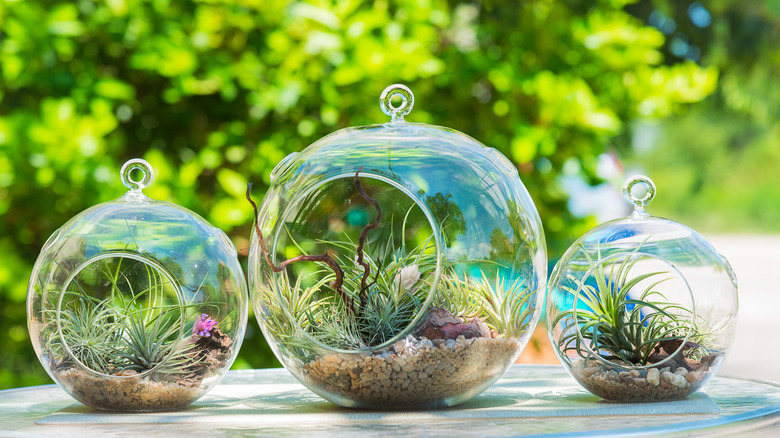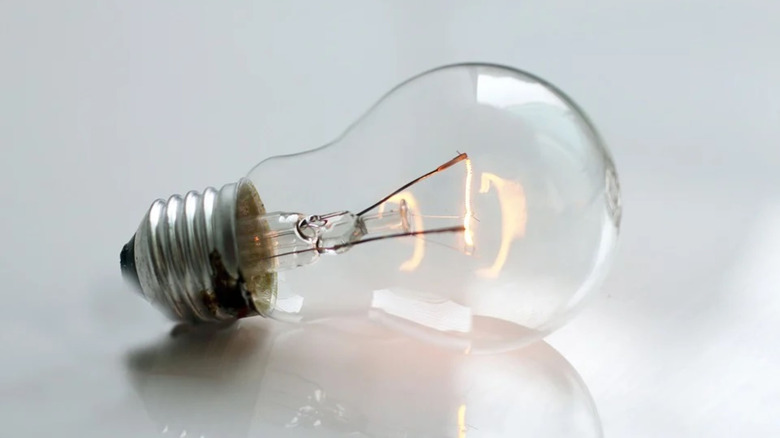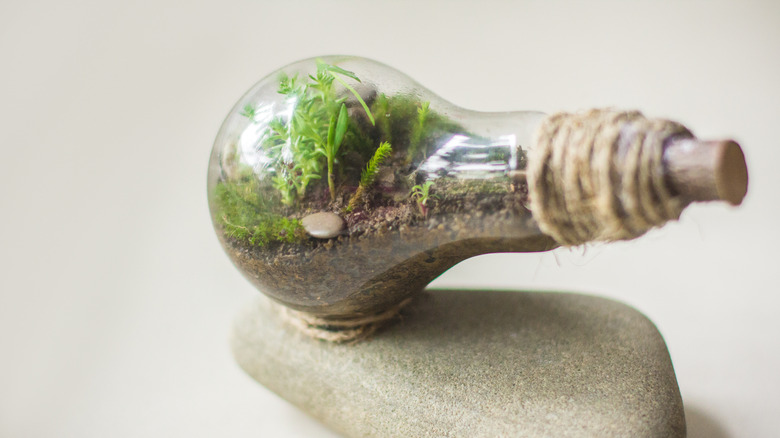Reuse An Old Lightbulb To Create The Perfect DIY Air Plant Terrarium
If there's a way to upcycle something you would otherwise toss out, we are here for it. Upcycling is not only good for Mother Earth; it often sparks creativity and a new generation of joy. In the past, we've made tiny terrariums out of antique jars, a DIY terrarium lamp out of an old pickle jar, and even turned an empty Tic Tac container into a mini terrarium with this creative DIY, but the possibilities don't end there. Before you toss a burned out lightbulb into the trash, consider giving it a second life as a terrarium. With a few tools and a delicate hand, you can open up the base of your lightbulb, fill it with dainty air plants, and close it back up for an awe-inspiring piece of décor.
By giving this DIY a try, you'll be keeping the bulb out of the landfill — and, better yet, you'll end up with a beautiful piece of plant art for your home. To help you determine which plants will thrive in your tiny terrariums, House Digest exclusively interviewed a houseplant expert. However, there are a few words of caution before we begin; make sure you're using only incandescent bulbs, since fluorescent lights contain hazardous chemicals. Also, always use safety goggles and gloves to protect yourself from broken glass or sharp objects within the bulb. For easy clean up, work within a confined space, like a low cardboard box, to contain any shards and loose pieces.
Preparing the terrarium for plant life
You'll first need to get through the base of the lightbulb before you get to the fun part of putting plants inside. Using tinsnips or needle-nose pliers, remove the metal contact tip at the center of the base. You also could use a razor blade to gently cut around the edge of the tip until it's loose enough to pull off with pliers. Next, detach the black seal surrounding the now-removed tip. This can be messy, since the seal usually doesn't come apart in one piece. Keep a firm grip on the bulb so it doesn't slip away, but not so tight that you accidentally shatter the glass. With the other hand, use pliers or a screwdriver to break apart and remove sections of the black material.
Now you're ready to work with what's inside the bulb. The next layer is a glass seal or mount that keeps the filament in place. This is also what keeps oxygen out of the bulb. Use a screwdriver to break and remove the glass. Then either pull out the filament with pliers or break it apart until the pieces are loose enough to shake out. Finally, run a damp towel along the bulb and base to remove any glass fragments, followed by a rinse under the sink. If the bulb has any printed words or numbers, you can rub them off with isopropyl alcohol or acetone. Now you're ready to add your terrarium substrates and air plants with the help of our exclusively interviewed expert.
Choosing plants and caring for your terrarium
For this project, go with one of the smallest air plants, which includes the Tillandsia ionantha "Mexican" and Tillandsia ionantha "Rubra," both averaging 1 to 2 inches. The Tillandsia ionantha "Scaposa," with its narrow foliage, is also ideal. One of the most appealing features of air plants is that they don't need growing medium. If you're using only air plants, you can skip the rocks, charcoal, and soil. For any other plants, add a base layer of tiny pebbles to help with drainage, and for extra protection against waterlogging and mildew, include ¼ to ½ inches of activated charcoal before layering potting soil. Use a funnel when inserting substrates to keep everything neat and to avoid smudging up the glass.
In an exclusive interview with House Digest, Carlie Paluzzi, co-founder of BWH Plant Co., recommended a few great terrarium companions for air plants. "Sheet moss (Hypnum imponens) or curtain moss (Leucobryum glaucum) are great options," says Paluzzi, "Their compact nature works really well in tight spaces." Using a small spoon or tweezers can make placing plants and moss much less of a struggle, she adds. Since moss thrives in humidity, either seal your light bulb with a cork or mist plants frequently. Tucking a delicate trailing Pilea glauca among the moss can add lovely texture and color. To display, wrap jute rope or string around the base of the bulb to hang the terrarium, or glue the lightbulb to a base for a tabletop display. When watering your plants, use a dropper or spray bottle, being careful not to overwater since the terrarium doesn't have drainage.


